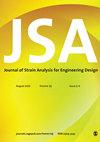AISI 4340钢铣削过程的有限元模拟失效力学分析
IF 1.8
4区 工程技术
Q3 ENGINEERING, MECHANICAL
Journal of Strain Analysis for Engineering Design
Pub Date : 2021-11-15
DOI:10.1177/03093247211058038
引用次数: 1
摘要
本文研究了一种使用旋转/平移平面立铣刀片的切槽操作。铣削操作通常包括上铣削和下铣削两个过程。这两种过程具有不同的行为和相反的力趋势,从而使操作具有复杂性。采用损伤起裂准则和损伤演化机理,建立了铣削过程的有限元模型。用实验结果验证了有限元模型的正确性,两者具有良好的相关性。在工件上跟踪失效准则场变量(JCCRT),观察加工过程中切削量和切削速率。结果表明,该模型能较好地预测加工过程中耗散的不同失效能量,并最终达到平衡。结果表明,这些能量随刀具旋转角度的变化符合切削过程中实际发生的物理现象。在所有能量中,塑性耗散能是系统总能量的主要贡献者。进一步进行了渐进式失效分析,观察了失效的性质以及加工过程中应力分量和温度的变化。本研究提出的模型将有助于设计人员和工程师在涉及现场加工的各种应用中规划他们的故障排除。本文章由计算机程序翻译,如有差异,请以英文原文为准。
Failure mechanics analysis of AISI 4340 steel using finite element modeling of the milling process
A slot cutting operation is studied in this paper using a rotating/translating flat end milling insert. Milling operation usually comprises up-milling and down-milling processes. These two types of processes have different behaviors with opposite trends of the forces thus making the operation complex in nature. A detailed Finite Element (FE) model is proposed in this paper for the failure analysis of milling operation by incorporating damage initiation criterion followed by damage evolution mechanism. The FE model was validated with experimental results and good correlations were found between the two. The failure criteria field variable (JCCRT) was traced on the workpiece to observe the amount and rate of cutting during the machining process. It was found that the model was able to predict different failure energies that are dissipated during the machining operation which are finally shown to be balanced. It was also shown that the variation of these energies with the tool rotation angle was following the actual physical phenomenon that occurred during the cutting operation. Among all the energies, plastic dissipation energy was found to be the major contributor to the total energy of the system. A progressive failure analysis was further carried out to observe the nature of failure and the variation of stress components and temperature occurring during the machining process. The model proposed in this study will be useful for designers and engineers to plan their troubleshooting in various applications involving on-spot machining.
求助全文
通过发布文献求助,成功后即可免费获取论文全文。
去求助
来源期刊

Journal of Strain Analysis for Engineering Design
工程技术-材料科学:表征与测试
CiteScore
3.50
自引率
6.20%
发文量
25
审稿时长
>12 weeks
期刊介绍:
The Journal of Strain Analysis for Engineering Design provides a forum for work relating to the measurement and analysis of strain that is appropriate to engineering design and practice.
"Since launching in 1965, The Journal of Strain Analysis has been a collegiate effort, dedicated to providing exemplary service to our authors. We welcome contributions related to analytical, experimental, and numerical techniques for the analysis and/or measurement of stress and/or strain, or studies of relevant material properties and failure modes. Our international Editorial Board contains experts in all of these fields and is keen to encourage papers on novel techniques and innovative applications." Professor Eann Patterson - University of Liverpool, UK
This journal is a member of the Committee on Publication Ethics (COPE).
 求助内容:
求助内容: 应助结果提醒方式:
应助结果提醒方式:


